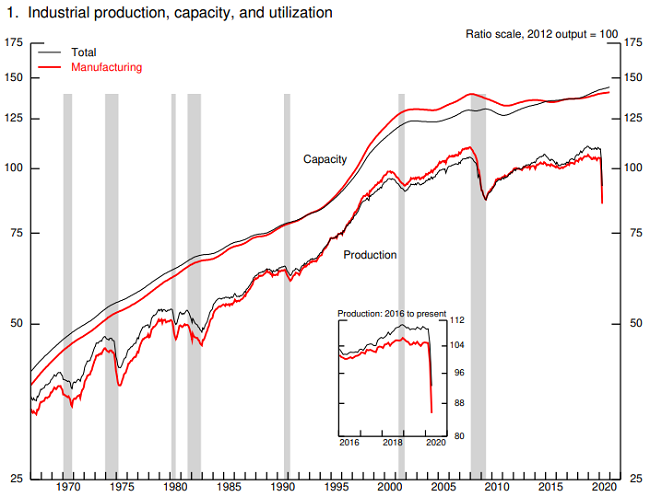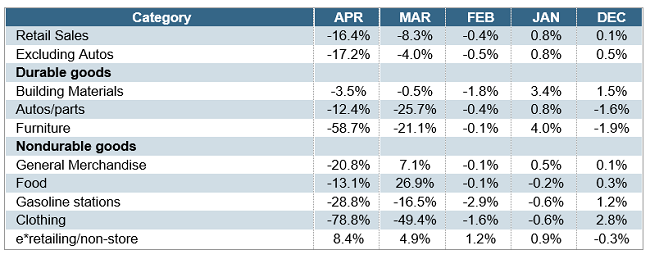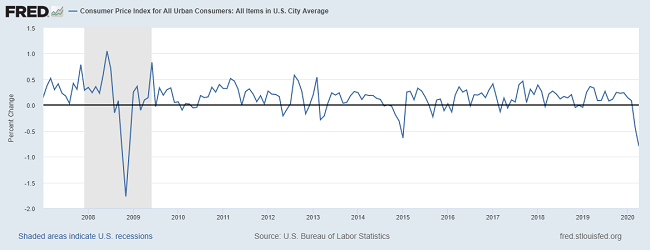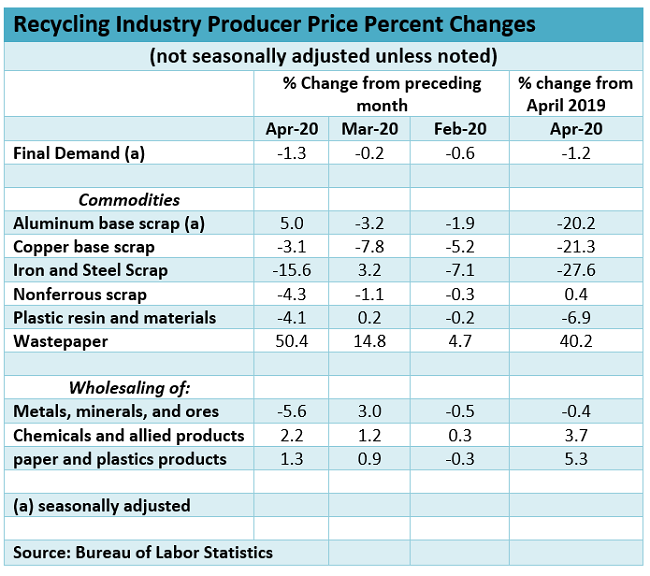Last week’s releases on industrial production, retail sales, consumer and producer price indexes, initial claims, and consumer sentiment supported/confirmed what is going on in the economy with respect to COVID-19. Shelter in place put a large volume of employees working from home and fewer in the work place, weighing on output, spending, and prices.
Industrial Production
The Federal Reserve reported last week that U.S. industrial production fell 11.2% in April, including declines of 13.7% for manufacturing, 6.1% in mine output, and 0.9% for utilities. The drop in industrial production marked the largest monthly drop in the 101-year history of the index, according to the Fed’s press release.

Retail Sales
U.S. retail sales plunged to $403.9 billion in April, a decline of 16.4% from March and down 21.6% as compared to one year ago, according to Census Bureau data. While e-retailing/non-store sales were up 8.4% for the month, that was more than offset by steep drops in auto and auto part sales (-12.4%), gasoline stations (-28.8%), clothing (-78.8%), and other sales categories in April. Briefing.com reports “The key takeaway from the report is that the broad-based weakness is a representation of the adverse spending shock that resulted from shutdown measures, announced pay cuts, and the massive jump in unemployment.”

Consumer Price Index
The consumer price index fell 0.8 percent on a seasonally adjusted basis in April 2020, double the amount the preceding month and its biggest one month decline since December 2008, according to the Bureau of Labor Statistics. To exemplify the magnitude of this decline, April 2020 is the fifth largest one month decrease since this series began in January 1947. In April 2020, the following areas incurred some of the largest declines from the previous month: gasoline (all types) fell 20.6 percent, car and truck rental fell 16.6 percent, motor vehicle insurance down 7.2 percent, airline fares down 15.2 percent lodging away from home decreased 7.1 percent and apparel down 4.7 percent. Many areas showed increased pricing during April 2020 from the previous month: food at home increased 2.6 percent with meats, poultry, fish and eggs up 4.3 percent – with eggs up 16.1 percent, hospital service up 0.5 percent, and health insurance increased 1.1 percent. Less food and energy, the index fell 0.4 percent, the smallest twelve-month change in the history of this index, which began in 1957.

Producer Price Index
The producer price final-demand index decreased in April 2020 by 1.3 percent on a seasonally adjusted basis, and the largest monthly decrease since the inception of this index in 2009, according to the Bureau of Labor Statistics.
As compared to the prior month, final demand for goods decreased 3.3 percent; final demand for services edged downward by 0.2 percent; final demand for foods was down slightly at 0.5 percent; the final demand for energy was down 19.0 percent; and trade services, that measure the changes in margins received by wholesalers and retailers, increased 1.6 percent.
Specific to the recycling industry (as shown in the table below), April 2020 saw increases for recovered paper and aluminum base scrap for the month (aluminum scrap was still down 20% as compared to one year ago), while ferrous, nonferrous, and copper scrap all realized month-on-month decreases.

University of Michigan Surveys of Consumers
Providing a glimmer of hope for the future, the U of M Consumer Sentiment Index surprised most everyone by increasing in May 2020 to 73.7, up from 71.8 in April, which was the lowest index number since December 2011 and above Wall Street’s consensus of 67.4. The Current Economic Conditions Index rose in May to 83.0, up from 74.3 in April. And the Index of Consumer Expectations declined slightly to 67.7 in May, from 70.1 in April.
Richard Curtin, chief economist for the Surveys of Consumers, stated, “Confidence inched upward in early May as the CARES relief checks improved consumers' finances and widespread price discounting boosted their buying attitudes. Despite these gains, personal financial prospects for the year ahead continued to weaken, falling to the lowest level in almost six years, with declines especially sharp among upper income households.”
And he added further insight into consumers’ top concerns: “The health threat dominated in both months, cited by 61% in April and 57% in May. The original hypothesis was that as their primary concerns shifted from health to finances, consumers would become less accepting of constraints on reopening the economy. Those that cited damages to their finances as their top concern fell to 17% in May from 22% in the prior month. Surprisingly, it was greater concerns about social isolation that increased, cited as the top concern by 21% in May up from 14% in April. While these shifts were quite small, they indicate the growing costs of social isolation and its potential to shift opinions about reopening the economy.”